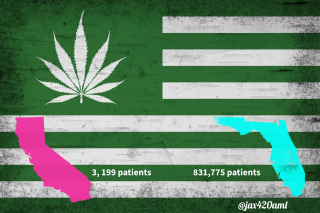Amendment 3 and Its Role in Florida’s Medical Marijuana Landscape

The Current State of Medical Marijuana in Florida: Amendment 3 and Its Role in Florida’s Medical Marijuana Landscape
The landscape of medical marijuana in Florida is undergoing significant changes, with Amendment 3 at the forefront of this transformation. As the state with the largest medical marijuana patient registry in the United States, Florida stands at a crucial juncture in its approach to cannabis legislation. The proposed amendment has sparked widespread debate and has the potential to reshape the state’s policies on medical and recreational marijuana use.
Current State of Medical Marijuana in Florida
Florida has emerged as a significant player in the medical marijuana landscape, boasting the largest patient registry in the United States. The state’s medical cannabis program has experienced substantial growth since its inception, with over 800,000 registered patients as of 2024. This remarkable expansion underscores the increasing acceptance and utilization of medical marijuana in the Sunshine State.

Patient Registry Size
The size of Florida’s medical marijuana patient registry is a testament to the program’s success. With nearly 1.5% of the state’s population enrolled, Florida has surpassed California to become the largest medical cannabis market in the country. This growth can be attributed to the state’s expanding list of qualifying conditions and the increasing awareness of medical marijuana’s potential benefits.
Qualifying Conditions
Florida’s list of qualifying conditions for medical marijuana use is comprehensive. It includes cancer, epilepsy, glaucoma, HIV/AIDS, PTSD, ALS, Crohn’s disease, Parkinson’s disease, and multiple sclerosis. Additionally, physicians have the discretion to recommend medical marijuana for other debilitating conditions they believe could benefit from cannabis treatment. This flexibility has allowed more patients to access medical marijuana, contributing to the program’s rapid expansion.
Dispensary System
The state’s dispensary system has grown alongside the patient registry. As of 2024, there are 22 licensed Medical Marijuana Treatment Centers (MMTCs) operating in Florida, with more licenses expected to be awarded. These MMTCs are vertically integrated, meaning they control all aspects of production from cultivation to retail sales. The number of dispensaries has increased significantly, with some companies operating over 100 locations statewide.
Despite the program’s success, challenges remain. The cost of medical marijuana can be prohibitive for some patients, as it is not covered by insurance. Additionally, while the number of dispensaries has grown, access can still be limited in certain areas of the state. As Florida’s medical marijuana program continues to evolve, addressing these issues will be crucial to ensuring equitable access for all eligible patients.
Amendment 3: Proposed Changes to Florida’s Cannabis Laws

Key Provisions
Amendment 3 aims to legalize recreational marijuana use for adults 21 and older in Florida. If passed, it would allow Floridians to possess, purchase, and use marijuana products without medical authorization. This change would also apply to tourists of legal age visiting the state.
The amendment would permit adults to possess, purchase, or use marijuana products and accessories for non-medical personal consumption through smoking, ingestion, or other methods. This provision represents a significant shift from the current medical-only model in Florida.
Potential Impact on Medical Program
The proposed amendment could have a substantial impact on Florida’s existing medical marijuana program, which is already the largest in the United States. With over 800,000 registered patients, Florida’s medical cannabis market is projected to grow from $1.75 billion in 2023 to $2.4 billion by 2026.
If Amendment 3 passes, it could potentially expand the market even further. However, it may also lead to changes in the current medical program structure. Some medical patients might transition to the recreational market, potentially affecting patient numbers and sales in the medical sector.
The amendment’s passage could also influence the operations of existing Medical Marijuana Treatment Centers (MMTCs). These vertically integrated companies might need to adapt their business models to serve both medical and recreational markets.
While the amendment aims to legalize recreational use, it’s important to note that it faces opposition. The Florida attorney general, along with other groups, is attempting to block the effort, calling it unconstitutional and accusing the state’s largest MMJ operator of trying to establish a monopoly on the adult-use market.
Despite these challenges, many cannabis companies are expanding their presence in Florida, anticipating potential adult-use legalization. This expansion includes opening new dispensaries and diversifying product offerings, demonstrating the industry’s optimism about the amendment’s possible passage.

Comparing Florida’s Medical Marijuana Program to Other States
Florida’s medical marijuana program has become one of the largest in the United States, with over 800,000 registered patients. This significant patient base sets Florida apart from many other states with medical cannabis programs.

Patient Numbers
Florida boasts the largest medical marijuana patient registry in the country, surpassing even California in terms of registered users. With nearly 1.5% of the state’s population enrolled, Florida has established itself as a leader in medical cannabis adoption. This rapid growth can be attributed to the state’s expanding list of qualifying conditions and increasing awareness of medical marijuana’s potential benefits.
Accessibility
While Florida has seen substantial growth in its medical marijuana program, accessibility remains a challenge in some areas. The state has 22 licensed Medical Marijuana Treatment Centers (MMTCs) operating, with more licenses expected to be awarded. These MMTCs are vertically integrated, controlling all aspects of production from cultivation to retail sales.
However, compared to some other states, Florida’s dispensary system is still developing. For example, some companies in Florida operate over 100 locations statewide, but access can be limited in certain regions. This contrasts with states like California or Colorado, which have more established and widespread dispensary networks.

Product Variety
Florida’s medical marijuana program offers a range of products to patients, including oils, edibles, and flower. However, the variety of products available may be more limited compared to some other states with longer-established programs. For instance, while Florida introduced edibles to its product lineup in August of 2020, states like California and Colorado have had a wider array of edible options for years.

Despite these challenges, Florida’s medical marijuana market is projected to grow significantly. The MJBiz Factbook estimates that Florida’s medical cannabis market will expand from $1.75 billion in 2023 to $2.4 billion by 2026, indicating continued growth and development in the state’s program.
As Florida’s medical marijuana program continues to evolve, it’s likely to see further expansion in patient numbers, accessibility, and product variety, potentially bringing it more in line with or even surpassing other well-established state programs.
Conclusion
Florida’s medical marijuana program has made significant strides, establishing itself as a leader in the field with the largest patient registry in the United States. The proposed Amendment 3 has the potential to cause a revolution in the state’s cannabis landscape, potentially expanding access and reshaping the existing medical program. As the debate continues, it’s clear that Florida’s approach to medical marijuana will have a lasting impact on patients, businesses, and the broader cannabis industry.

Looking ahead, the future of medical marijuana in Florida seems promising, with projected market growth and ongoing discussions about expanding access. To consider the potential benefits of medical marijuana, eligible individuals may want to explore their options. Make an appointment to get your medical marijuana card with Affordable Marijuana License today!


